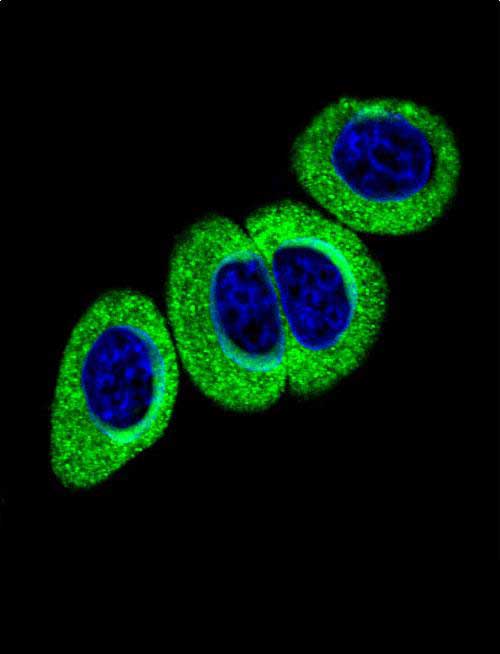

| WB | 咨询技术 | Human,Mouse,Rat |
| IF | 咨询技术 | Human,Mouse,Rat |
| IHC | 咨询技术 | Human,Mouse,Rat |
| ICC | 1/10-1/50 | Human,Mouse,Rat |
| FCM | 咨询技术 | Human,Mouse,Rat |
| Elisa | 咨询技术 | Human,Mouse,Rat |
| Aliases | Serine-protein kinase ATM, Ataxia telangiectasia mutated, A-T mutated, ATM |
| Entrez GeneID | 472 |
| WB Predicted band size | 350.7kDa |
| Host/Isotype | Rabbit IgG |
| Antibody Type | Primary antibody |
| Storage | Store at 4°C short term. Aliquot and store at -20°C long term. Avoid freeze/thaw cycles. |
| Species Reactivity | Human, Mouse, Rat |
| Immunogen | This Phospho-ATM-pS1981 antibody is generated from rabbits immunized with a KLH conjugated synthetic phosphopeptide corresponding to amino acid residues surrounding S1981 of human ATM. |
| Formulation | Purified antibody in PBS with 0.05% sodium azide. |
+ +
以下是关于Phospho-ATM(S1981)抗体的3篇参考文献,按文献发表时间排序:
1. **"DNA damage activates ATM through intermolecular autophosphorylation and dimer dissociation"**
- **作者**: Bakkenist, C.J., Kastan, M.B.
- **摘要**: 本文首次报道ATM在DNA损伤后第1981位丝氨酸(S1981)的自磷酸化是激活其激酶活性的关键步骤,该抗体用于检测ATM在电离辐射后的构象变化。
2. **"ATM and ATR substrate analysis reveals extensive protein networks responsive to DNA damage"**
- **作者**: Matsuoka, S. et al.
- **摘要**: 通过Phospho-ATM(S1981)抗体验证ATM在DNA损伤后的激活状态,揭示了ATM下游底物网络及其在细胞周期检查点调控中的作用。
3. **"Activation and regulation of ATM kinase activity in response to DNA double-strand breaks"**
- **作者**: Kozlov, S.V. et al.
- **摘要**: 利用Phospho-ATM(S1981)抗体证明DNA双链断裂诱导ATM二聚体解离并自磷酸化,阐明其激活机制与肿瘤抑制功能。
如需更多文献或具体应用案例,可进一步补充说明研究方向(如癌症、神经退行性疾病等)。
Phospho-ATM (S1981) antibody is a crucial tool for studying the activation and functional regulation of the ATM (ataxia-telangiectasia mutated) kinase, a central player in the DNA damage response (DDR). ATM, a member of the phosphatidylinositol 3-kinase-related kinase (PIKK) family, is activated primarily in response to DNA double-strand breaks (DSBs). Its activation involves autophosphorylation at serine 1981 (S1981), which induces a conformational change, releasing the inactive dimeric form into active monomers. The Phospho-ATM(S1981) antibody specifically recognizes this phosphorylation event, serving as a marker for ATM activation.
This antibody is widely used in research to investigate DDR mechanisms, particularly in contexts like cancer, neurodegeneration, and radiation biology. It helps assess ATM activation kinetics following genotoxic stress (e.g., ionizing radiation or chemotherapeutic agents) and is valuable in studying diseases linked to ATM dysfunction, such as ataxia-telangiectasia (A-T), a disorder caused by ATM mutations. Applications include Western blotting, immunofluorescence, and immunohistochemistry to visualize spatial-temporal ATM activation in cells or tissues.
Importantly, the antibody’s specificity for the phosphorylated S1981 residue ensures accurate detection of ATM’s active state, distinguishing it from inactive forms. Researchers also utilize it to explore cross-talk between ATM and other DDR pathways (e.g., ATR, DNA-PK) or to evaluate therapeutic responses in preclinical models. However, optimal results require proper sample preparation to preserve phosphorylation status, often involving phosphatase inhibitors. Overall, Phospho-ATM(S1981) antibody remains indispensable for dissecting DNA repair mechanisms and their implications in disease.
×